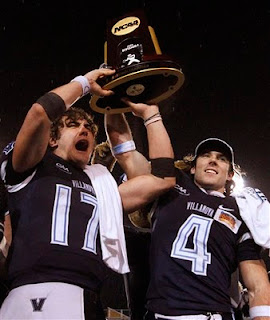A note from FishDuck.com: Today we have a unique treat, this article from a highly successful college coach gives an inside perspective football fans don’t often get to see, the direct insight of football concepts from a coach.
We encourage other coaches that are interested in possibly writing guest columns providing their unique insight to please contact us. For now, here is Coach Brian Flinn!
I have been fortunate throughout my coaching career–from my start at Mount Union with Larry Kehres until the present day at Villanova with Andy Talley–to work with coaches who are constantly searching for a better way to do things.
Despite a great tradition of offense here at Villanova University, we are not so set in our ways that we are not above discarding them for something better. At the end of the 2007 season this search lead us to seriously consider changing what we did, how we did it, and how we communicated it to our players. The end result–thanks to a lot of help from some of the best programs in the country–was the best three year run in the history of our program.
Our offensive background here at Villanova is rich in tradition. Two offensive skill position players have won the Walter Payton Award (Brian Finneran-1997, Brian Westbrook-2001), and there have been numerous All-Americans and NCAA Statistical champions.
The majority of this success was achieved with a classic (huddling) West Coast offense. Our offensive coordinator Sam Venuto, who took over in 1999, developed this system and used it to expand on the offensive tradition we have here at Villanova. Our plays consisted of numbered calls with several words thrown on the end. We signaled the calls in to the quarterback, who then communicated the play to the huddle. Practices and games operated at a constant (and some would say somewhat pedestrian) pace. We demanded better “tempo” from the players during practice, but gave them no legitimate way of accomplishing that goal.
Like many offenses in football today, over the course of the previous five seasons we saw a gradual shift in our philosophy from a two-back to a single-back set. This change was rooted into the type of players we were recruiting at Villanova, and what they were able to do well.
We began to run more plays out of the shotgun, more “constraint” plays (bubbles, read options, smoke screens, etc.) and moved from man-blocking schemes to zone-blocking schemes. The search to find better ways to utilize our players’ strengths and time inevitably lead to the consideration of running the No-Huddle offense.
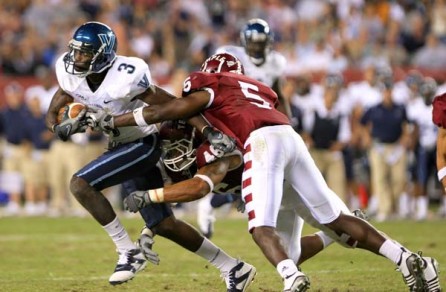 By 2007, we had not made the playoffs since 2002, had a good young team returning and were looking for a way to maximize our talent and our practice time. We had experimented briefly with the No-Huddle in the past…a wristband here, a series of plays there. The results of these experiments were mixed, as they most always are when using such a small sample size.
By 2007, we had not made the playoffs since 2002, had a good young team returning and were looking for a way to maximize our talent and our practice time. We had experimented briefly with the No-Huddle in the past…a wristband here, a series of plays there. The results of these experiments were mixed, as they most always are when using such a small sample size.
Whether it’s an operating system, a play/scheme or a style of offense, the outcome will most always be in direct relation to how much is invested in it. We dabbled in the No-Huddle and had the middling results that would be expected when putting in such a small amount of time and energy into something.
Chris Spielman once said “You don’t date the spread offense, you marry the spread offense.” We were slowly learning a relationship with the No-Huddle had to be just as committed.
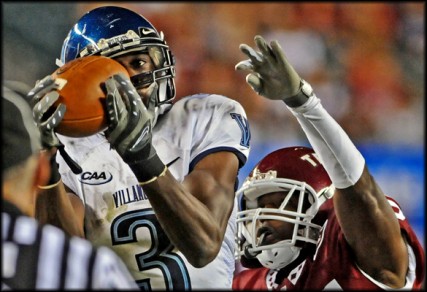 Our reservations to running a No-Huddle system were on par with what we heard from other coaches considering a similar transition. We had a large investment in the terminology we had used the previous eight seasons. We were concerned that a new system of play calls and signals would be too complex for our players. Even the loss of the mythical positive influence of the “QB taking control in the huddle” was addressed as a concern. Ultimately, all of these issues proved to be just that–myths. Our players and coaches handled the transition with the energy and attention to detail that it deserved.
Our reservations to running a No-Huddle system were on par with what we heard from other coaches considering a similar transition. We had a large investment in the terminology we had used the previous eight seasons. We were concerned that a new system of play calls and signals would be too complex for our players. Even the loss of the mythical positive influence of the “QB taking control in the huddle” was addressed as a concern. Ultimately, all of these issues proved to be just that–myths. Our players and coaches handled the transition with the energy and attention to detail that it deserved.
Prior to making the final decision to commit to the No-Huddle, we decided to research the best systems in the country. We are very fortunate here at Villanova to have a head coach who takes professional development seriously and provided us with the opportunity to travel and research. During my time at Villanova our offense has been tweaked, improved upon and transformed by the resources Coach Talley has provided us, and the generosity of others in the coaching profession. The best example of this generosity was our research into the No-Huddle offense.
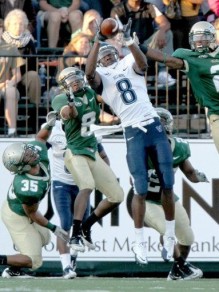 We were equally fortunate that the elite No-Huddle offenses in the country opened their doors to us. Places like Central Michigan (now the staff at Cincinnati), Appalachian State (who we ended up playing in the Playoffs in 2010), Missouri, Florida, Louisiana Tech and a host of others were extremely helpful. Coaches like Zach Azzanni (then at Central Michigan now at Wisconsin), Mike Bajakian (Cincinnati), Scott Satterfield (App State), Brian Jones (Missouri), Pierre Ingram (LA Tech) and Zach Yenser (LA Tech) gave us volumes of great information. Once we saw the No-Huddle being taught in the meeting rooms and in action on the field, we were convinced it was the next logical step for our offense.
We were equally fortunate that the elite No-Huddle offenses in the country opened their doors to us. Places like Central Michigan (now the staff at Cincinnati), Appalachian State (who we ended up playing in the Playoffs in 2010), Missouri, Florida, Louisiana Tech and a host of others were extremely helpful. Coaches like Zach Azzanni (then at Central Michigan now at Wisconsin), Mike Bajakian (Cincinnati), Scott Satterfield (App State), Brian Jones (Missouri), Pierre Ingram (LA Tech) and Zach Yenser (LA Tech) gave us volumes of great information. Once we saw the No-Huddle being taught in the meeting rooms and in action on the field, we were convinced it was the next logical step for our offense.
Our reservations about the theory of the No-Huddle did not hold up once we saw it in practice. Rather than struggle with the transition, players relished the change and the opportunity to help in the creation of play names and signals. Coaches on our staff who had used the same terminology for almost a decade were energized by the chance to build something new. The naming process (taking a numbered system and changing it into words and signals), which we feared would take weeks, was completed in under a day. What we thought would be a finite number of available signals and play names has proved to be the exact opposite.
Five years later, we are never at a loss for a new name or signal if the need arises. The clichéd concerns about toughness, leadership and communication were discounted because we build those things every day in our program (in the weight room, meeting room and on the practice field)–not in a huddle immediately prior to a play.
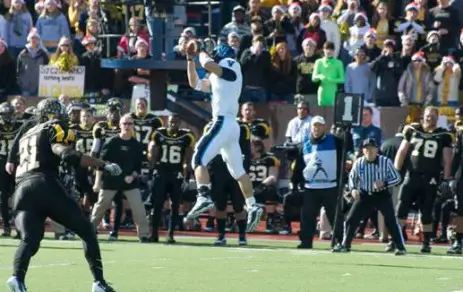 The most immediate benefit we saw from the No-Huddle was the pace of practice. Watching Central Michigan practice under Butch Jones in the spring was what I thought a practice should be; there was no down time, excessive amounts of reps, and the entire team was involved in practice at all times. Watching the Chips practice was like watching gasoline being thrown on a fire play-after-play.
The most immediate benefit we saw from the No-Huddle was the pace of practice. Watching Central Michigan practice under Butch Jones in the spring was what I thought a practice should be; there was no down time, excessive amounts of reps, and the entire team was involved in practice at all times. Watching the Chips practice was like watching gasoline being thrown on a fire play-after-play.
While not up to this standard immediately, our practices took on a decidedly different look from the beginning. Scripts were completed with a minute-plus left on the 5-minute period clock. Subsequently, team segments expanded from 12 plays, to 16, to 24. Injured players were given scripts and told to signal rather than ride a bike or stare into space during team time. Gone was the 45-second dissertation to a player who stepped the wrong way or lined up on the wrong side, that correction would now be made in the meeting room or when his four plays on the field were up. In place of that downtime were extra reps we never would have gotten if we were still conducting a huddle prior to every play.
Wide receivers at Villanova have been very successful in their no-huddle offense.
Our first live game running the No-Huddle was at West Virginia in 2008. There would be no better environment for us to test our new operating system. Despite the 48-21 loss, we felt there were some encouraging signs. We ran 49 offensive plays in the first half, and avoided any major communication problems or substitution issues in a hostile environment.
We also discovered that despite practicing and conditioning at a furious pace, we still weren’t in shape to run the offense at the speed we wanted to do so. It would be critical for us to continue to push the speed of our operation in practice if we wanted to push our opponents during games.
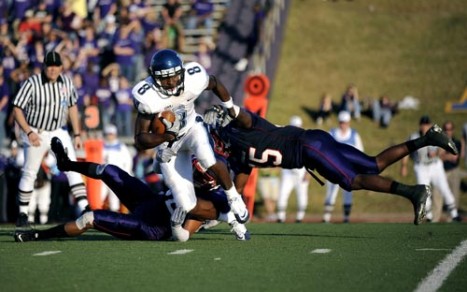
Villanova wide receiver Norman White tries to get past Stephen F. Austin State University defenders during a playoff game at Homer Bryce Stadium in Nacogdoches, Texas. (Staff photo by Andrew Rogers)
As the season progressed our results continued to discredit many, if not all, of our concerns. Despite never getting into a huddle, we spent the season in the top-five in the country in rushing, had few communication issues, and got great leadership from our quarterback position.
Our conditioning and pace during games improved every week. In comparison to the season before, there was a dramatic spike in the number of plays we ran, our time of possession, total yards, and rushing yards in the second half. Our veteran offensive line wore down opposing front-sevens late in halves and games. We ran a small number of concepts, but still had the flexibility to add to our offense when the game plan required it. Our offense became much more about how we play than what scheme we were running.
Because we spent 100% of practice and games without a huddle, our two-minute end of half/game procedures were very similar to our standard operating ones. This carry over helped improve our efficiency in these critical situations. We were also able to play four-minute situations, check plays (although we rarely did) and handle most any clock or game management issue that presented itself.
In our 1st year running the No-Huddle we could not have been more pleased with the results–a 10-3 record, one of the top rushing seasons in Villanova history, and our first trip to the playoffs since 2002. The following two seasons would be the best two-year stretch in our program’s history–23 wins, a CAA and National Championship in 2009, and a National Semi-Finals appearance in 2010.
It has been great to watch and learn from other No-Huddle teams across the country as we try to build on our own system. There are so many great high school and college programs using and developing the No-Huddle offense.
We had a chance to study Chip Kelly for a number of years while he was calling plays in our league at New Hampshire, and continue to do so while his offense evolves at Oregon. We have broken down countless No-Huddle offenses, studying the pace and operation as much as the scheme. The high school staffs who visit Villanova, many of whom have been running the No-Huddle for much longer and much better than we have, often times give us as many good ideas as they get from us.
Innovation, inspiration and video clips now come from all sports and eras: from Unitas and Berry running the two-Minute offense, to (now Oregon women’s basketball coach) Paul Westhead’s Loyola-Marymount basketball teams, to the Bills and Bengals of the late 80’s-early 90’s, to Mike D’Antoni’s “7 Seconds or Less” offense, to even Charles Fischer’s FishDuck.com.
 The No-Huddle is now our culture. To us, being a huddling team or a slow team would be a fate worse than death. The No-Huddle has changed the way we practice, script and coach; all for the better. It has changed how we condition, lift weights, and meet. Efficiency and speed is who we are and what we strive to be. We spend practice and meeting time emphasizing and brainstorming ways to go faster, to make the offense simpler, and more streamlined.
The No-Huddle is now our culture. To us, being a huddling team or a slow team would be a fate worse than death. The No-Huddle has changed the way we practice, script and coach; all for the better. It has changed how we condition, lift weights, and meet. Efficiency and speed is who we are and what we strive to be. We spend practice and meeting time emphasizing and brainstorming ways to go faster, to make the offense simpler, and more streamlined.
The No-Huddle has opened up areas to help us improve that previously would not have occurred to us. Thanks to the generosity of others in this great profession, it’s an exciting time to be a football coach, and to be at Villanova.
We look forward to what the future of football will bring.
Related Articles:
Chip Kelly Update: Everything's Good Again ...
Chip Kelly Update: Wailing and Gnashing of Teeth
Shock and Awe -- The Oregon Ducks' Football Hangover Effect
Despite Lopsided Score, Georgia State "Never Stopped Believing"
Hope Springs Eternal for Ducks
Incompetent Pac-12 Officials: How Do You Miss ALL of THIS?
Coach Brian Flinn (Football Analyst) is entering his seventh year as Villanova University’s Wide Receivers Coach and Recruiting Coordinator. A native of Youngstown, OH, Brian Flinn was an All-OAC tight end at Mount Union College before entering the coaching ranks. In addition to Villanova, Coach Flinn has coached at Eastern Illinois University, Drake University, Maryland University, and Mount Union.
Go Villanova Wildcats!



